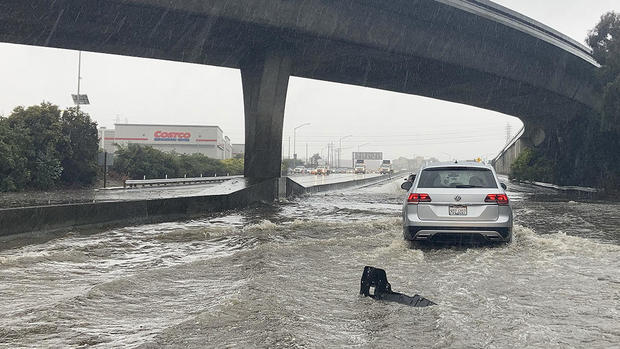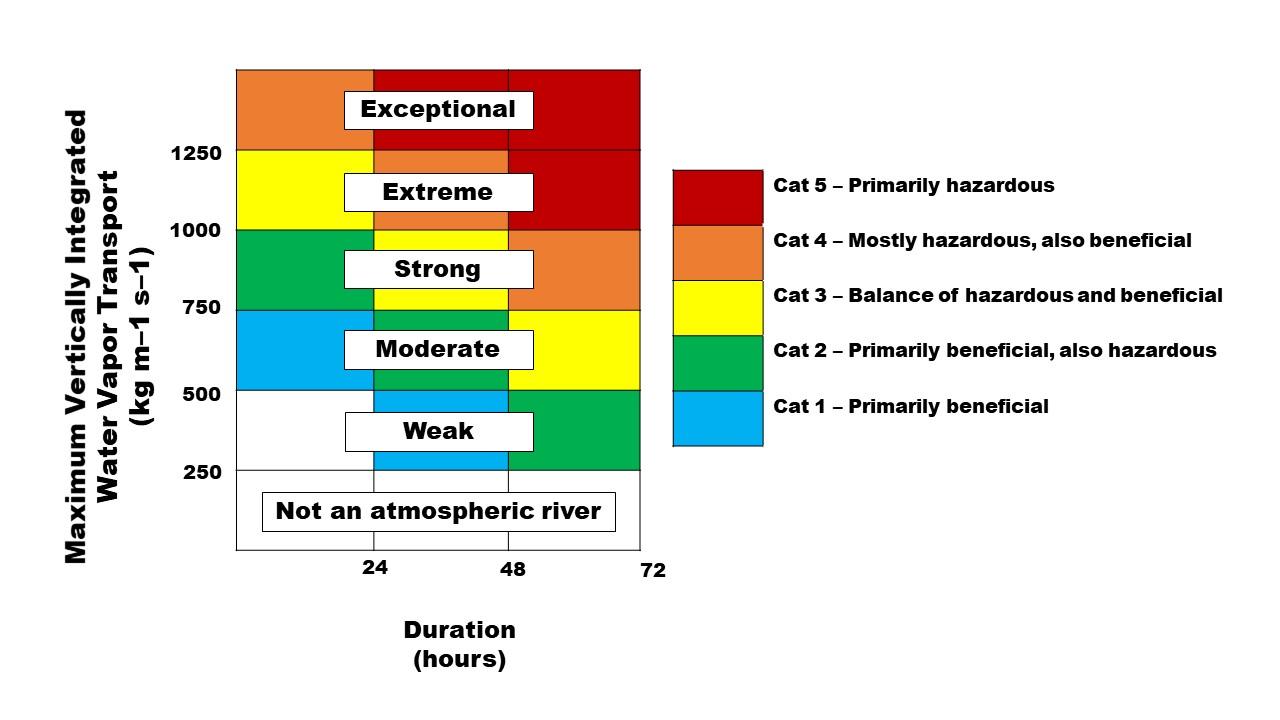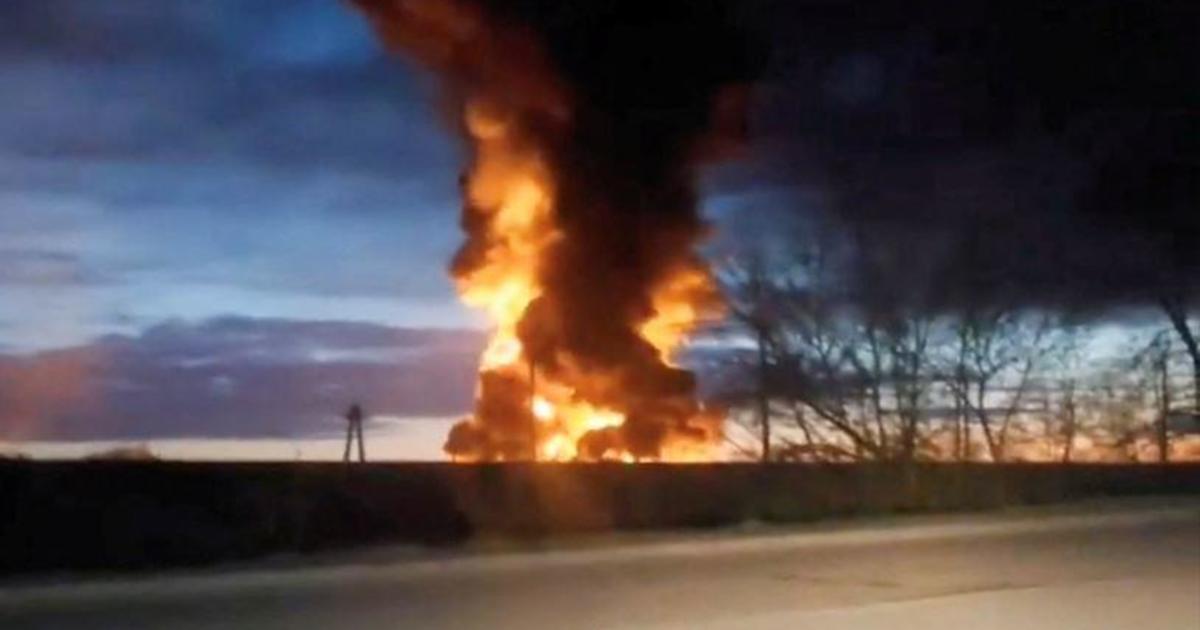Another atmospheric river is hitting California. What's behind these damaging storms?
Another "atmospheric river" is bringing widespread flooding to parts of California this week — and it's not the first time the strong, damaging weather phenomenon has wreaked havoc in the state in recent days. The atmospheric river hitting the region this week will be the third since Dec. 26.
And the latest storm is expected to be even more intense than the last:
"To put it simply, this will likely be one of the most impactful systems on a widespread scale that this meteorologist has seen in a long while," read a statement from the National Weather Service's Bay Area office. "The impacts will include widespread flooding, roads washing out, hillside collapsing, trees down (potentially full groves), widespread power outages, immediate disruption to commerce, and the worst of all, likely loss of human life. This is truly a brutal system that we are looking at and needs to be taken seriously."
While the region will likely experience similar flooding in creeks and streams, downed trees, mudslides and power outages to the Dec. 31 storm, the National Weather Service said main rivers, such as the Russian River near Guerneville, could "approach or reach flood stage."
What is an atmospheric river and why are they in the forecast for the West Coast?
What are atmospheric rivers?
Atmospheric rivers are long regions in the atmosphere that transport water. The water vapor they carry is roughly equivalent to the average flow of water at the mouth of the Mississippi River, according to the National Oceanic and Atmospheric Administration. So, when they make landfall and release all that water, they can cause extreme flooding.
They are an important part of the world's ocean water cycle, often contributing to water supplies, NOAA points out.
"They are extremely important to the water supply in the Western United States and are part of the earth's ocean water cycle," The Weather Channel Meteorologist Jacqui Jeras told CBS News. "The snowpack in the mountains in particular is important for drought relief and filling reservoirs. It's like saving up money in the bank during these events to be spent in the spring when the snow melts and fills the reservoirs."
How destructive are they?
In 2009, an atmospheric river that hit northwest Britain carried about 4,500 times the amount of water than the River Thames in London, causing extreme flooding in the area, according to a 2013 study by University of Reading and University of Iowa.
A 1998 study by MIT found an atmospheric river can have the same moisture flux as the Amazon River — carrying about 176,000 tons of water per second.
The United States Geological Survey says high-intensity atmospheric rivers can be as destructive as hurricanes. Similar to hurricanes, they have a rating system, but their ratings incorporate the idea that they can be beneficial, hazardous or both. A Category 1 atmospheric river would be primarily beneficial, while a Category 5 would be primarily hazardous, the USGS explains. The latest storm is forecast to be a Category 3, according to CBS Bay Area chief meteorologist Paul Heggen.
In addition to heavy flooding, atmospheric rivers can also cause landslides and strong winds that can knock over trees and power lines.
Not all atmospheric rivers cause damage, and they can bring necessary rain or snow to enhance water supplies. Such was the case in 2010, when an atmospheric river brought 11 to 25 inches of rain to parts of the West Coast and much-needed snowpack, or the snow in the mountains, according to NOAA.
The recent atmospheric river that hit California over New Year's weekend caused heavy flooding in the San Francisco Bay Area as well as landslides of rock and mud that closed roads across the area. Thousands of Pacific Gas and Electric customers lost power during the storm, CBS San Francisco reported.
The National Weather Service Bay Area said 5.46 inches of rain was dumped on San Francisco on Dec. 31 – making it the second wettest day in more than 170 years of records for that area. Oakland had its wettest day on record since 1970 while Redwood City had its third wettest since 1906
A flood advisory was issued for much of the Bay Area, which has been lifted. The atmospheric river also brought snowpack to the Sierra Nevada mountain range and Lake Tahoe.
How common are they?
In 2015, an atmospheric river that was more than 5,000 miles long accompanied a massive Atlantic storm called Storm Desmond, causing widespread flooding in the U.K., Ireland and Norway.
There are seven atmospheric rivers present in the world at any given time — and they're not just on the West Coast of the U.S., according to the Weather Channel.
The 2013 study by University of Reading and University of Iowa found the phenomenon may become more common in the U.K. and cause more severe winter flooding. The increase in atmospheric rivers is caused by climate change, researchers say.
In 2010, the Mid-Atlantic states in the U.S. experienced a "snowmageddon," which was made worse by an atmospheric river.
Atmospheric rivers often make the rainy season in China, known as Mei-Yu season, even worse.
A well-known atmospheric river is the "Pineapple Express" — this is the system that brings water from Hawaii over to the mainland U.S.
In the Sierra Nevada, atmospheric rivers are 2.5 times more likely to result in destructive "rain-on-snow" events — when rain falls on snowpack and freezes — than other types of winter storms, according to a study by NASA.
"Atmospheric rivers can happen almost anywhere across the globe, but are most notable in the United States across the West," Jeras said.
And while just 17% of storms on the West Coast are caused by atmospheric rivers, they contribute to 30% to 50% of California's precipitation. They also contribute to 40% of Sierra snowpack, and more than 80% of the state's major floods, the NASA study found.
Atmospheric rivers are predictable and can sometimes be forecast up to a week in advance, says the Weather Channel. Similar to using hurricane hunter aircraft to track hurricanes, Scripps Institution of Oceanography can drop sensors into atmospheric rivers to collect data on them.
"It is not uncommon to have multiple ARs every winter. The rain and snow pack we've had so far in the West will not bust the drought, but it is a good start," Jeras said, adding that while there can be devastating impacts from these storms, "we need the snow to keep coming in the mountains and to stay frozen until the spring to bring a more substantial impact."
What to expect
On Tuesday, the National Weather Service San Francisco warned the area is experiencing a calm before another storm. It issued a warning for flooding and winds from Wednesday into Thursday as an atmospheric river moves through the region, and also warned other weather systems will bring additional rain and winds into next week, urging Northern California residents to "make a plan now!"
"Saturated soils and strong winds will likely bring down trees leading to power outages and blocked roads," the service warned.
The storm was expected to affect Sacramento and Los Angeles as well.






